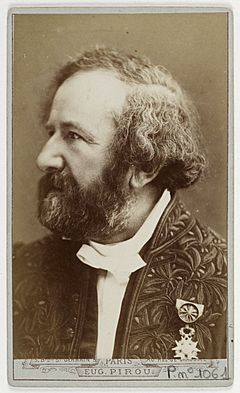Hippolyte Fizeau facts for kids
Quick facts for kids
Hippolyte Fizeau
|
|
|---|---|

Hippolyte Fizeau in 1883 by Eugène Pirou
|
|
| Born | 23 September 1819 |
| Died | 18 September 1896 (aged 76) Venteuil, France
|
| Nationality | French |
| Known for | Fizeau experiment Fizeau interferometer Fizeau wheel Fizeau's measurement of the speed of light in air Doppler–Fizeau effect Astronomical interferometry Capacitor Optical dilatometer Redshift |
| Awards | Rumford Medal (1866) FRS (1875) |
| Scientific career | |
| Fields | Physics |
Armand Hippolyte Louis Fizeau (born September 23, 1819, died September 18, 1896) was a French physicist. He is famous for his work on light. In 1849, he measured the speed of light with great accuracy. Later, in 1851, he studied how light moves through water in an experiment known as the Fizeau experiment.
Contents
Early Life and Discoveries
Fizeau was born in Paris, France. His first studies focused on making photography better. He worked with another scientist, Léon Foucault, to explore how light and heat waves interact. This is called interference.
Understanding Light Waves
In 1848, Fizeau made an important prediction. He said that electromagnetic waves, like light, would change color if their source was moving away. This change is called redshift. It means light waves stretch out, making them appear redder.
Measuring the Speed of Light
One of Fizeau's biggest achievements was measuring the speed of light in 1849. He used a clever setup:
- He sent a beam of light to a mirror about 8.6 kilometers (5.3 miles) away.
- The light beam passed through the gaps of a spinning wheel.
- This wheel had 720 teeth.
- Fizeau slowly increased the wheel's speed.
- When the wheel spun at 12.6 rotations per second, the light returning from the mirror hit a tooth and was blocked.
- When the wheel spun twice as fast (25.2 rotations per second), the light could be seen again.
Using these measurements, Fizeau calculated the speed of light to be about 313,274,304 meters per second. This was very close to the actual speed of light, which is 299,792,458 meters per second. His measurement was within 5% of the correct value!
Light in Different Materials
In 1850, Fizeau also measured how light travels at different speeds in air and water. He used a spinning mirror for this experiment. Another scientist, Léon Foucault, found the same results around the same time.
The Doppler–Fizeau Effect
Fizeau also helped discover the Doppler effect. This effect explains how the frequency of a wave (like sound or light) changes if the source of the wave is moving. For example, a siren sounds different as it moves towards or away from you. In French, this is often called the Doppler–Fizeau effect.
Other Inventions and Studies
In 1853, Fizeau explained how to use a capacitor to make induction coils work better. Capacitors store electrical energy. He also studied how solids expand when heated. He used light interference to measure how much crystals expand.
Later Life and Legacy
Fizeau became a member of the Académie des Sciences in 1860. This is a very important scientific group in France. He also joined the Bureau des Longitudes in 1878, which deals with time and astronomy. He passed away in Venteuil on September 18, 1896.
Fizeau's name is honored in several ways:
- His name is one of the 72 names written on the Eiffel Tower in Paris. These are names of famous French scientists, engineers, and mathematicians. Fizeau was the only one of the 72 who was still alive when the tower opened in 1889.
- A crater on the far side of the Moon is named Fizeau after him.
See also
- Daguerreotype
- Michelson stellar interferometer
- Optical chopper
- Léon Foucault
- In Spanish: Hippolyte Fizeau para niños

